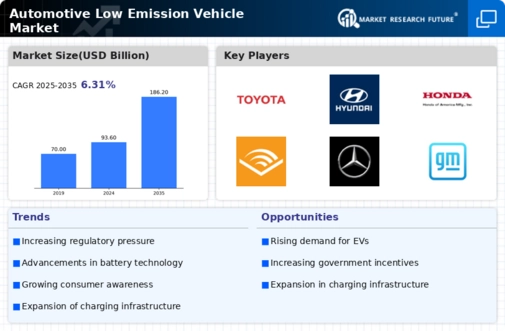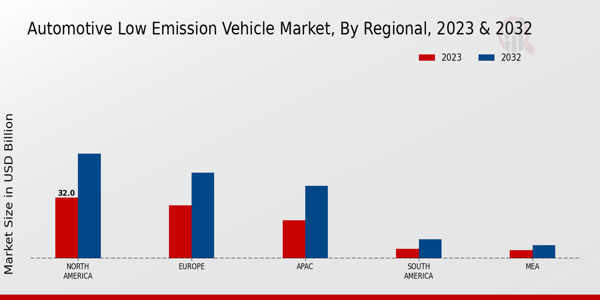Global Economic Factors
Global economic factors, including fuel prices and economic stability, significantly influence the Global Automotive Low Emission Vehicle Market Industry. Fluctuations in fuel prices can drive consumers towards low emission vehicles, as these vehicles often offer lower operating costs. Additionally, economic stability encourages investments in new technologies and infrastructure, fostering a conducive environment for the growth of low emission vehicles. As economies recover and grow, the demand for sustainable transportation options is expected to rise. This interplay between economic conditions and consumer preferences is likely to shape the market dynamics in the years ahead.
Market Growth Projections
The Global Automotive Low Emission Vehicle Market Industry is poised for substantial growth, with projections indicating a market value of 93.6 USD Billion in 2024 and an anticipated increase to 186.2 USD Billion by 2035. This growth trajectory suggests a compound annual growth rate of 6.46% from 2025 to 2035. Such figures underscore the increasing investment in low emission technologies and the rising consumer demand for sustainable transportation solutions. The market's expansion is likely to be driven by a combination of regulatory pressures, technological advancements, and shifting consumer preferences, positioning it as a critical segment within the broader automotive industry.
Infrastructure Development
The expansion of charging infrastructure is crucial for the growth of the Global Automotive Low Emission Vehicle Market Industry. As electric vehicles become more prevalent, the need for accessible and efficient charging stations increases. Governments and private entities are investing in the development of charging networks to alleviate range anxiety among consumers. For instance, initiatives to install fast-charging stations along major highways and urban areas are underway in various countries. This infrastructure development not only supports the adoption of electric vehicles but also enhances the overall market appeal of low emission vehicles. The availability of robust charging infrastructure is likely to facilitate market growth in the coming years.
Technological Advancements
Technological advancements play a pivotal role in shaping the Global Automotive Low Emission Vehicle Market Industry. Innovations in battery technology, electric drivetrains, and fuel efficiency are driving the development of vehicles that produce fewer emissions. For example, advancements in lithium-ion batteries have increased the range and performance of electric vehicles, making them more appealing to consumers. Furthermore, the integration of smart technologies, such as regenerative braking and energy-efficient systems, enhances vehicle efficiency. These technological strides are expected to contribute to a compound annual growth rate of 6.46% from 2025 to 2035, indicating a robust future for low emission vehicles.
Consumer Awareness and Demand
Growing consumer awareness regarding environmental issues is a key driver for the Global Automotive Low Emission Vehicle Market Industry. As individuals become more conscious of their carbon footprints, there is an increasing demand for vehicles that align with sustainable practices. Surveys indicate that a significant percentage of consumers are willing to pay a premium for low emission vehicles, reflecting a shift in purchasing behavior. This trend is further supported by the rise of eco-friendly initiatives and campaigns promoting sustainable transportation. Consequently, the market is anticipated to expand, with projections suggesting it could reach 186.2 USD Billion by 2035, driven by this heightened consumer demand.
Government Regulations and Incentives
The Global Automotive Low Emission Vehicle Market Industry is significantly influenced by stringent government regulations aimed at reducing greenhouse gas emissions. Countries worldwide are implementing policies that mandate lower emissions standards for vehicles, thereby encouraging manufacturers to invest in low emission technologies. For instance, the European Union has set ambitious targets for CO2 emissions, compelling automakers to innovate. Additionally, various governments are offering incentives such as tax rebates and subsidies for consumers purchasing low emission vehicles, which further stimulates market growth. As a result, the market is projected to reach 93.6 USD Billion in 2024, reflecting the impact of these regulatory frameworks.


























